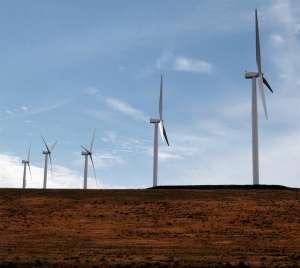
There’s a $36 billion marketplace that may double in size in the near future. It’s the renewable energy sector – and it’s definitely worth watching.
The United States ranks second only to China in leading the world in electricity generated from renewable sources. And, interestingly enough, Texas is home to one of the world’s largest renewable energy sources in a small city.
Last year, renewable energy accounted for more than 13.4 percent of domestically produced power and 11.1 percent of total energy generation. Wind, solar and other renewable energy sources are quickly becoming an integral part of renewable energy portfolios.

Photo by Steven Jackson licensed under CC BY 2.0
Texas is the hands-down leader and record-setter in wind power. Iowa and California are next in line. In Texas, wind power accounted for 11.7 percent of the electricity generated last year. One of the largest producers is the Roscoe Wind Farm, where wind turbines – more than 630 of them – amount to almost half the total number of residents in the city.
All but four states have incentives in place to promote renewable energy and 29 have adopted renewable portfolio standards for investor-owned utilities. More than a dozen states have renewable energy laws and most have highly publicized renewable energy goals. Massachusetts legislators recently took up an energy bill that would require the state to obtain almost 20 percent of its power from renewable energy sources.
Hawaii has one of the more ambitious goals for renewables. It hopes to have 100 percent renewable energy reliance by 2045. Oregon recently joined Hawaii, Vermont and California as a state with the highest renewable portfolio standards in the country.
California has a goal of reaching 50 percent renewable energy by 2030. Vermont has until next year to reach its first goal of 55 percent. New York officials plan to have 50 percent of all electricity sold in the state coming from renewable sources by 2030.
Other states have more modest goals. Pennsylvania is seeking 18 percent from renewable sources by 2021. Rhode Island says it will have 14.5 percent by 2019 and Arizona expects renewable energy to make up 15 percent of its energy portfolio by 2025.
Texas and Iowa are unique because their standards require specific amounts of renewable energy capacity rather than a percentage of total electricity generated. The 1999 legislation deregulating the energy industry in Texas established mandates for the use of renewable energy and the Public Utility Commission followed up by mandating renewables with a goal of 10,000 MW of renewable energy capacity by 2025. Texas reached and surpassed its 2025 goal in 2009.
The renewable energy marketplace is expanding, creating jobs, diversifying the energy mix forever and shoring up local and state economies. The Department of Energy’s National Renewable Energy Laboratory predicts that the United States will generate most of its electricity from renewable sources by 2050, thereby establishing an even larger marketplace for renewable solutions.
Renewable energy projects are abundant and more are being planned. Companies with services and solutions related to renewable energy are probably too busy at the moment to even stop and read about this huge and ever-expanding marketplace. It’s a trend gaining momentum every year!
SPI’s newsletters are excellent sources of information for the latest in government procurement. Subscribe here.
